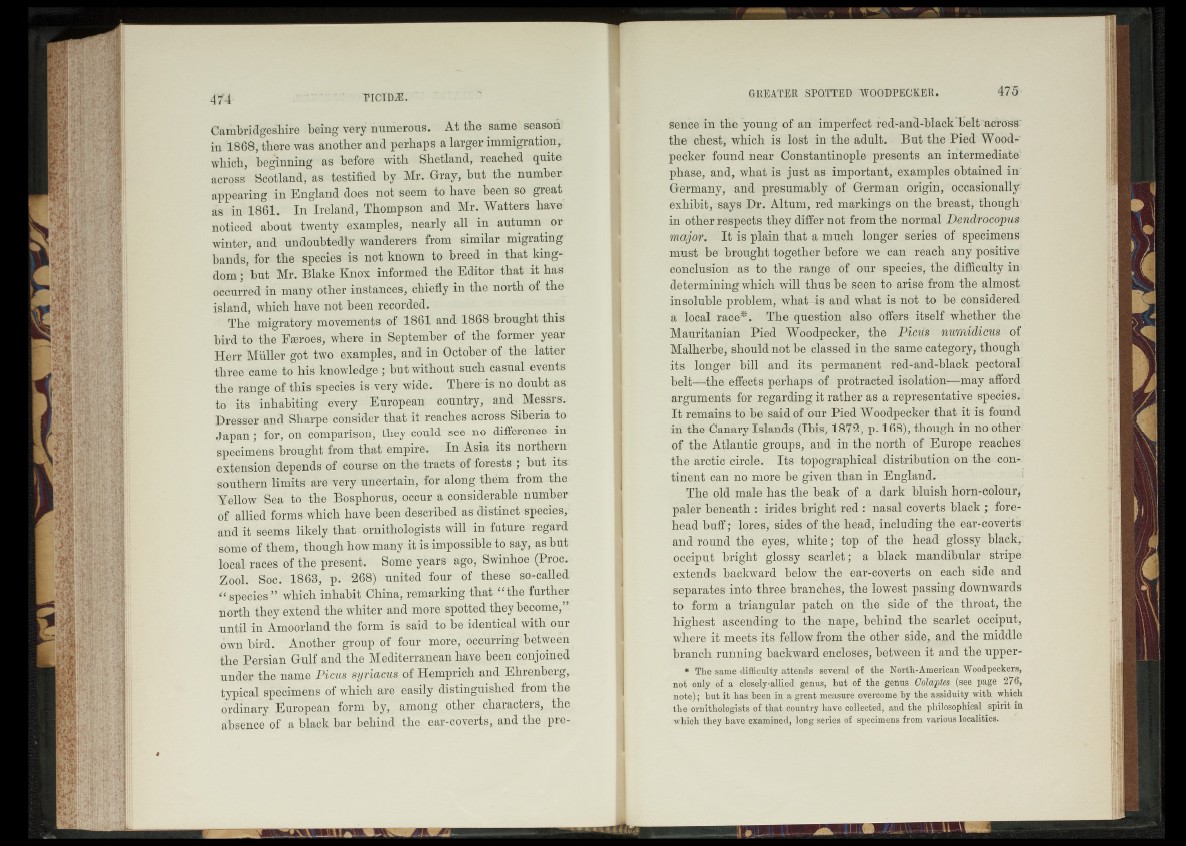
Cambridgeshire being very numerous. At the same season
in 1868, there was another and perhaps a larger immigration,
which, beginning as before with Shetland, reached quite
across Scotland, as testified by Mr. Gray, but the number
appearing in England does not seem to have been so great
as in 1861. In Ireland, Thompson and Mr. Watters have
noticed about twenty examples, nearly all in autumn or
winter, and undoubtedly wanderers from similar migrating
bands, for the species is not known to breed in that kingdom
; but Mr. Blake Knox informed the Editor that it has
occurred in many other instances, chiefly in the north of the
island, which have not been recorded.
The migratory movements of 1861 and 1868 brought this
bird to the Faroes, where in September of the former year
Herr Muller got two examples, and in October of the latter
three came to his knowledge; but without such casual events
the range of this species is very wide. There-iS no doubt as
to its inhabiting every European country, and Messrs.
Dresser and Sharpe consider that it reaches across Siberia to
Japan; for, on comparison, they could see no difference in
specimens brought from that empire. In Asia its northern
extension depends of course on the tracts of forests ; but its
southern limits are very uncertain, for along them from the
Yellow Sea to the Bosphorus, occur a considerable number
of allied forms which have been described as distinct species,
and it seems likely that ornithologists will in futuie legald
some of them, though how many it is impossible to say, as but
local races of the present. Some years ago, Swinhoe (Proc.
Zool. Soc. 1868, p. 268) united four of these so-called.
(‘species’* which inhabit China,remarking that the further
north they extend the whiter and more spotted they become,
until in Amoorland the form is said to be identical with our
own bird. Another group of four more, occurring between
the Persian Gulf and the Mediterranean have been conjoined
under the name Pious syriacus of Hemprich and Ehrenberg,
typical specimens of which are easily distinguished from the
ordinary European form by, among other characters, the
absence of a black bar behind the ear-coverts, and the pre-
Sence in the young of an imperfect red-and-black belt across'
the chest, which is lost in the adult. But the Pied Woodpecker
found near Constantinople presents an intermediate
phase, and, what is just as important, examples obtained in
Germany, and presumably of German origin, occasionally
exhibit, says Dr. Altum, red markings on the breast, though
in other respects they differ not from the normal Dendrocopus
major. It is plain that a much longer series of specimens
must be brought together before we can reach any positive
conclusion as to the range of our species, the difficulty in
determining which will thus be seen to arise from the almost
insoluble problem, what-is and what is not to be considered
a local race*. The question also offers itself whether the
Mauritanian Pied Woodpecker, the Pious numidicus of
Malherbe, should not be classed in the same category, though
its longer bill and its permanent red-and-black pectoral
belt—the effects perhaps of protracted isolation—may afford
arguments for regarding it rather as a representative species.
It remains to be said of our Pied Woodpecker that it is found
in the Canary Islands (Ibis, 1872, p. 168), though in no other
of the Atlantic groups, and in the north of Europe reaches
the arctic circle. Its topographical distribution on the continent
can no more be given than in England.
The old male has the beak of a dark bluish horn-colour,
paler beneath : irides bright red : nasal coverts black; forehead
buff; lores, sides of the head, including the ear-coverts
and round the eyes, white; top of the head glossy black,;
occiput bright glossy scarlet; a black mandibular stripe
extends backward below the ear-coverts on each side and
separates into three branches, the lowest passing downwards
to form a triangular patch on the side of the throat, the
highest ascending to the nape, behind the scarlet occiput,
where it meets its fellow from the other side, and the middle
branch running backward encloses, between it and the upper-
* The same difficulty attends several of the North-American Woodpeckers,
not only of a closely-allied genus, but of the genus Oolaptes (see page 276,
note); but it has been in a great measure overcome by the assiduity with which
the ornithologists of that country have collected, and the philosophical spirit in
which they have examined, loDg series of specimens from various localities.